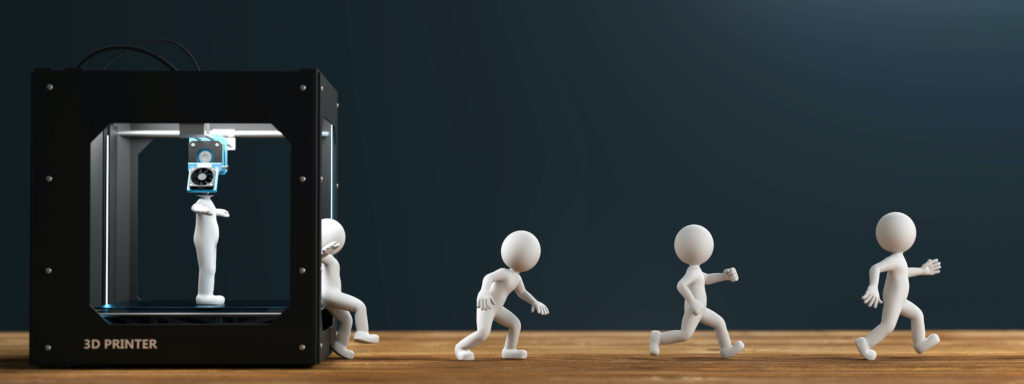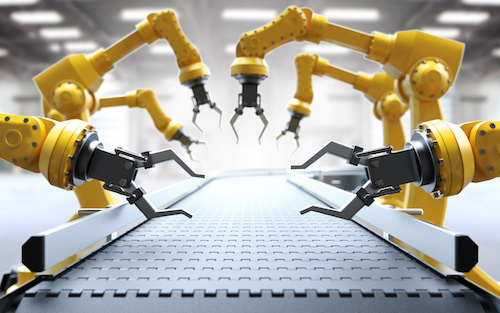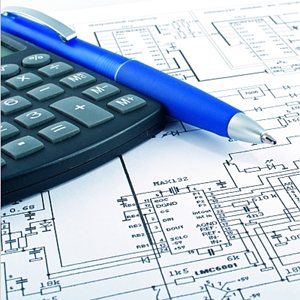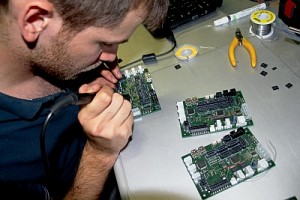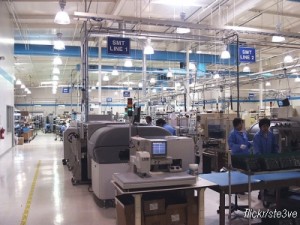 ANY manufacturer or entrepreneur who has brought a product to market knows that just having a great idea is not enough. Progressing a product from a simple idea or customer demand to commercialisation is a long, uncertain one, and for those who do not have the engineering expertise, the path can be even more daunting.
ANY manufacturer or entrepreneur who has brought a product to market knows that just having a great idea is not enough. Progressing a product from a simple idea or customer demand to commercialisation is a long, uncertain one, and for those who do not have the engineering expertise, the path can be even more daunting.
Contract design firms can help smooth the road from concept to commercialisation, but as with any form of outsourcing, along with the opportunities come some potential pitfalls.
Electronics News talked to three electronics design contract firms, Successful Endeavours, LX Design House and RTD Circuit Design, for their perspective on how companies utilising their services can maximise their value for money, and perhaps revolutionise their product in the process.
What they do
Whether it’s an innovative start-up, entrepreneurial individual inventors who need a prototype, companies needing a next-generation iteration of an existing product, or anyone in-between, at the core of every product is a seed of an idea or need. But a special set of design and engineering skills are needed to nurture the seed and grow it into a real product.
But those skills are in short supply. “A lot of clients have let their technical capability go,” says Ray Keefe, owner and managing director of Melbourne-based Successful Endeavours. “Many don’t even know how to put a product specification together anymore.”
Industry statistics are hard to come by, but according to the Andrew Pollock of the Surface Mount & Circuit Board Association (SMCBA), figures held by the association indicate there are between 150 to 200 electronics design engineering companies in Australian industry, with around 30 percent of them being small contract operations.
The rest of the country’s design engineers are employed by larger organisations like BAE,Cochlear, Black Magic Design and CSIRO. Despite this good design base, the fact remains that a lot of development work (especially for global companies) has moved overseas. The migration of in-house engineering and product development expertise, especially from the small to medium enterprises (SME), has left gaps that electronic design contractors now attempt to fill.
The type of clients seeking contract design services can vary in size, capability and work requirements. Depending on how far along a they are in the product development process (for example, some have an idea of what the product needs to do; others may already have a schematic or partly working product), clients may subcontract part or the whole of the design process, from product specification to engineering analysis, schematic design, PCB layout, prototyping, software development, and post production support and revision.
However, outsourcing, while common, is not the only way contractors get involved with projects. According to Keefe, around a third of his company’s clients ask the contractor to augment the client’s existing design teams, to provide specialty skills. In the case of Successful Endeavours, that includes analogue design, low power design and embedded software.
Simon Blyth, director of LX Design House, says his company adopts a similar approach for a number of its clients because some cannot completely outsource their projects. “With some projects, there’s so much internal knowledge that it’s hard to write a spec and outsource it,” Blyth explained. “We go on site to act as a resource to help them complete the project and provide a specialist skill set.”
 Due to the diversity of the projects contract design firms have to deal with, it’s a constant challenge for companies like LX Design House to find engineers with the right skills.
Due to the diversity of the projects contract design firms have to deal with, it’s a constant challenge for companies like LX Design House to find engineers with the right skills.
“I don’t mean [just] good engineers,” Blyth told Electronics News. “I mean engineers who are exceptionally passionate and exceptionally talented, at an elite level. As a design house, I don’t think we can afford to have mediocre engineers.
“In a design house, you are expected to go into any different company, or industry or technology, and be able to perform at a very high level. You really do need high calibre engineers to make that work.”
The quote
For many first-time clients, the quote is seen as a key part of the process, and some may pick and choose design contractors according to price.
Rob Leslie, manager of RTD Circuit Design, focuses on printed circuit board (PCB) layout services. His company also provides consulting on component selection and product manufacturability.
Leslie uses a spreadsheet to work out the amount of man hours a project will take, which he then multiplies with the hourly rate. The spreadsheet takes into account the difficulty involved in laying out the PCB (for example, a long and skinny format is harder to work with than a square or circular board with the microcontroller in the middle), placement and layering specifications, as well as constraints on things like track impedances.
Successful Endeavours understands that most customers see products as an investment, on which a return is expected. The firm offers hourly rates as an option, but derives 80 percent of its business from a fixed price for fixed deliverables model. Larger projects are usually broken up into phases, with the client buying one phase at a time, and estimated costs reviewed between phases.
According to Keefe, customers are fairly intolerant of price hikes, so contract design firms tend to be very assiduous when delivering quotes and estimates. That said, the price may be revised if during the course of the project, previously unknown factors and issues arise.
Crystal clear
Quote revisions and scope ‘creep’ are the stuff of project nightmares, and are usually symptoms of outsourced projects where the two parties have different notions of what the other wants. The solution is having clear communications from beginning to end. The responsibility for this lies with both the client and the contractor.
Contractors utilise various processes from the get go to ensure they are ‘on the same page’ as their clients. LX Design House, for example, has a formal specification procedure.
The firm draws up a separate document called an acceptance test criteria, based on the specification of a proposed product. This document clearly explains how the resulting product will be tested to ensure the objectives have been met. It is critical for a client to read, understand and agree to this document, as it will largely determine the final performance and function of their product.
“I believe that specs are … only half of the equation,” Blyth explains. “It’s only fair that once the client receives the product, if the product doesn’t meet the acceptance test criteria, then it’s something that we need to remedy.
 “But if the product does meet the acceptance test criteria, and the client dreams up or realises there’s a new criteria that they want to add, that’s a change request,” he says. “It’s a fair line in the sand where both parties can agree if something is a change, or a prior requirement.”
“But if the product does meet the acceptance test criteria, and the client dreams up or realises there’s a new criteria that they want to add, that’s a change request,” he says. “It’s a fair line in the sand where both parties can agree if something is a change, or a prior requirement.”
Successful Endeavours applies a similar approach, with the specificity of the design work clearly demarcated according to stages, starting with the general user requirements progressing to product requirements (specifications and features), and engineering requirements, which guide the design team to the specific outcomes the product must deliver.
Any requests are documented and returned to the client for confirmation, and quotes are always accompanied with a clearly defined description of the work involved and the expected outcomes.
During the day-to-day workings of projects, all three contract design firms contacted by Electronics News emphasised the importance of regular face-to-face meetings, telephone calls, emails and other forms of communication to ensure both sides were fully aware of the progress of the work.
It’s clear that contracting a design job is much more than just writing a specification document and letting the contractor get on with it. Both sides must be engaged throughout the process to ensure everyone understands what needs to be done.
Equally important is for clients and design contractors to break down the ‘silo’ mentality, especially when it comes to internal and proprietary product information. If the design contractor is reputable and has signed a non-disclosure agreement (NDA), its engineers should be allowed to access the product information that is critical to the success of the project.
“Even if you’re subcontracting work, you’re essentially still part of the same team trying to achieve the same objective,” Blyth says.
Keefe agrees, but points to a larger challenge concerning the mindset of many companies “One of the issues for the Australian marketplace is that many companies are very insular,” he explains. “They don’t collaborate very well with other companies, and treat everyone with suspicion. This has really worked against the Australian industry.”
First to market
The concept of working as a team can yield tangible benefits for clients, not just in terms of the final product spec, but also from a business perspective. All three companies Electronics Newsspoke to have methodologies in place to accelerate the product development process.
For example, RTD Circuit Design utilises a quick circuit milling machine to engage in a rapid prototyping process. This is especially useful if the customer stipulates the use of a pre-manufactured enclosure without providing schematics.
“We make a dummy board on the machine with no tracks, just the profile and the critical mounting holes, solder some components on and make sure it fits on the box,” Leslie says. “That’s a way to make sure odd-shaped boards fit when they come back from the factory.”
LX Design House adopts an accelerated approach for clients who have a lower budget and prefer less documentation. “We can take the general needs of the client, deliver something quickly with a low document approach, and give it to them,” Blyth says. “They can play with it and see what they do and don’t like, then we do a new spin … and give them a quote for the changes.”
Getting the product into the customers’ hands during the development process is an effective way to short circuit issues that might come up later. While Successful Endeavours may modify a spare piece of hardware to create an early prototype, the same approach also applies to the software functionality of the product.
 According to Keefe, with the proliferation of low-power, high throughput processing chips, software has become a very important part of product development, with many functionalities moving from being hardware-based to being embedded in software. There’s no longer a clear division between software and hardware development: embedded developers are working with both.
According to Keefe, with the proliferation of low-power, high throughput processing chips, software has become a very important part of product development, with many functionalities moving from being hardware-based to being embedded in software. There’s no longer a clear division between software and hardware development: embedded developers are working with both.
Keefe says his firm uses PCs to create and run a complete emulation of the system, utilising high-level language to build a ‘shell’ on which the firmware or embedded software can run. Clients can then run development versions of the on-chip software on their computers and test for functionality. This can be a real life saver in some scenarios.
“One of the customers we worked with had nearly finished their circuit board design, so we were just developing software for them. We introduced this software methodology to them as part of the development process,” Keefe recalls.
“At the point where their PCB was about to be finalised, they received news from the supplier of the main processor that the component was now on 52 weeks lead time.
“They had a final PCB, but now needed to change the chip,” says Keefe. “Our process allowed us to keep developing and testing the software while they picked a new processor.
“Three months later, when they finally had a circuit board to run everything on, we had fully working software ready to load onto their system. That saved them quite a number of months in terms of time-to-market.”
Trend savvy
Because of the exposure that contract designers have to a wide variety of projects, they have a good idea about the latest technologies and capabilities on the market, and can bring a fresh perspective to a project.
While many businesses will have a fairly detailed idea of how a project should pan out, having an open mind to new ideas suggested by the contract design engineers could make the final product better, or reduce the cost of development.
“Companies come to without realising all of the options that are available to them. They can get the most value out of us by allowing us to introduce some of these ideas into the product early [in the schedule],” Keefe says.
One way to reduce the cost of the final product is to have a modern user interface. Products that use a lot of buttons and indicators LED as the interface can be expensive to manufacture, with a bulky and complex final design. “We are tending to move clients towards LCD-based interfaces with soft menus, because it makes it easier to give the user more information about the selections. It’s also more flexible to upgrade in the future,” Keefe says.
 With an LCD-based interface, new features can be added in a software upgrade as additional menu options, whereas button-heavy interfaces might have to resort to complicated combination button presses.
With an LCD-based interface, new features can be added in a software upgrade as additional menu options, whereas button-heavy interfaces might have to resort to complicated combination button presses.
Keefe cited another example of a company he is working with who had a development roadmap for their product, and an idea of what it should be capable of doing in three years’ time. A month into the project, he had a conversation with the client on its final goal.
“I asked them didn’t just aim for the final product now and they said because it was too much work, but I told them it’s no more work than what they’re already asking for, because there was a whole bunch of things they didn’t know [adding to the work load of the current project],” Keefe says.
“We’ve changed direction, and in about four weeks’ time, they’re going to have the product that they thought they couldn’t have for another three years,” he adds. “There’s a big advantage to being to market much earlier with the product you really wanted rather than going through a series of stages.”
If a contract design company can help differentiate a client’s product then it can result in increased sales. For example, in 2011, Successful Endeavours won the Industrial Electronics category ofElectronics News’ Future Awards for its work on the ABB CQ900R power systems controller.
The controller is commonly located on the top of poles in remote areas. Previous versions required power technicians to drive up to the pole, deploy a ladder, climb up to the unit with a laptop, and plug it in to interrogate the controller.
Recognising the possibilities afforded by low-power wireless for the application, the design contractor suggested the feature to ABB. “They asked how much it cost, and when we told them, it became a ‘no-brainer’,” Keefe told Electronics News. “The development and hardware costs were low, and it’s an up-sell option.”
The wireless feature allowed technicians to interact with the units from their vehicles, and became a winning function of the product helping win extra customers. ABB was also able to sell versions of the product with and without the wireless feature for increased market differentiation.
Contract designers are also privy to other trends that can help improve the design of products. For example, devices are increasingly being designed with self-test features which can reduce production line costs. Additionally, design contractors like LX Design House are seeing a shift from stand-alone devices to platforms which can be adapted to different functions.
“There is still a place for very specific product,” LX’s Blyth says. “But for some projects we take the approach of developing it as a platform that can be built upon in the future as opposed to just being a ‘one-hit’ wonder.”
Blyth emphasised the importance for design contractors to proactively invest in keeping up with changes. This not only helps with value adding, but can be a serious advantage when pitching for projects.
“We buy development kits or new technologies when they come out, so our guys get to [understand] them,” Blyth explains. “[So] we can speak meaningfully about it and have some experience … to take on the first project [that uses the technology].”
Transition to manufacturing
Since any successful product development cycle culminates in the manufacture of the device, design contractors place a lot of focus on manufacturability. Fortunately, new manufacturing capabilities and technologies such as 3D visualisation and increased machine precision have made designer’s job easier.
For example, RTD Circuit Design’s Rob Leslie says if need be, components can be placed at odd angles, and pick and place on both sides of the board is fairly normal these days.
“Back in the old days, components had to be loaded in boards by hand, and designers were asked to put diodes facing the same way round so the operator could check easily to make sure they’re right,” Leslie says. “Those things don’t apply anymore with machine placement and machine inspection.”
Like other design houses, Successful Endeavours employs a few basic and conservative design rules to accelerate and enhance an initial design.
 “We tend to work with larger track-to-track clearances and groundplane-to-track clearances than the industry average,” Keefe explains. “Unless the PCB design is really tight on space, its better to put more work into making sure it’s easy to make [rather than densely packed].”
“We tend to work with larger track-to-track clearances and groundplane-to-track clearances than the industry average,” Keefe explains. “Unless the PCB design is really tight on space, its better to put more work into making sure it’s easy to make [rather than densely packed].”
While Keefe is knowledgeable about the capabilities of a number of different equipment manufacturers, he will consult with specific firms about design rules to suit their production processes. This includes considerations such as the smallest track size, clearances and SMD ‘neck-downs’ among others.
“A big constraint is called shadowing,” Keefe says, noting one typical manufacturability challenge. “For SMT boards, if you have a large, tall, or bulky component, there will be a shadow area around it where [manufacturers] don’t want us to place small flat components on the boards [because they won’t solder properly]. We will want to know what those rules are so we can lay out the board appropriately.”
Once manufacturability has been covered, testing and certification needs to be agreed. LX Design House’ Simon Blyth likens this process to insurance for the product.
“Everyone hates ‘homing pigeons’: you don’t want to get a product out there that’s going to come back,” Blyth says.
Testing is a three-stage process, starting with firmware, then standards and certifications, and finally environmental testing.
In the first stage, the software running on the unit is put through integration testing and automated test scripts to ensure proper functionality and useability. Exceptions may be included in the test procedure ensure proper error handling.
The hardware is then tested to ensure compliance with standards or certification requirements. If the device is destined for safety applications, the appropriate diligence studies must be performed. Similarly, the relevant industry standards must be tested for, as well as country-specific certifications.
The final stage, depending on the intended operating environment for the device, may involve tests for vibration, shock, thermal cycling, mean time between failure and UV exposure.
As product tests can be costly, testing usually takes place when the development process is at the material prototype stage, with few or no design changes remaining. Timing tests properly eliminates the need for re-testing.
Off-shoring
With constant communication and expertise such a critical part of product development, there’s a strong case for keeping the work with local contractors, even though design firms in regions like Asia may offer highly attractive pricing. Perhaps for this reason, work for local electronics design firms is by no means thin on the ground.
Australian contract designers have done enough rescue work for “botched” jobs to know that problems like fraud, delays or non-functional final products can have costs in lost opportunities far outweighing the initial price advantage.
However, local design companies are by no means hostile to the notion of helping clients with off-shoring the work. According to Blyth, for example, the focus at LX Design House is to ensure the client gets the best outcome, and if using an overseas design house is the solution, so be it.
“I would encourage someone who is looking to offshore to engage a local design house to help them manage the process or even ask the right question,” Blyth explains. “We’ll help them figure out whether it’s a good thing to do for a project or not. [But] there are some [mission-critical] projects that you just can’t send offshore.”
At the end of the day, effective communication and accountability is the key to successful development, whether it’s done in-house, outsourced, or off-shored.
But choosing the right contract electronics design engineer with the expertise and experience could be the difference between an ordinary product as originally specified, and a value-added, differentiated result which blows initial sales expectations out of the water.
http://www.electronicsnews.com.au/features/how-to-contract-electronic-design-work
LX is an award-winning electronics design company based in Sydney, Australia. LX services include full turnkey design, electronics, hardware, software and firmware design. LX specialises in embedded systems and wireless technologies design. www.lx-group.com.au



